Executive Summary
Customer Relationship Management (CRM) is an essential means to enable the active business lives to impress absolutely its customers with its individualised, situational, and perceptual customer service. ‘Customer Relationship Management of BMW in UK’ depends on the causal motivation of modern CRM system and it will investigate to what extent the application of CRM can contribute to finding the way out to overcome the recessionary impacts by improving its CRM standard. The present economic condition demonstrates that the risk of decreasing sales and reduced profit leads BMW UK to restructure its strategies to overcome the most competitive and complex situation. CRM is one of the wide rapping cultured practices in modern business that can gather new customers maintain and retain them successfully.
The present dissertation “Customer Relationship Management (CRM) of BMW in UK” aimed to investigate the implication of implement CRM and draw conclusions, which will support the development of a recommendation for triumphant implementation of CRM. With this exposure, this study has undertaken a review of the literatures regarding Customer Relationship Management and identified the clear areas of consideration in this regards. A crystal clean justification has been provided for implementing CRM and devises a logical business case on BMW UK.
The aim of this dissertation is to explore the implications of Customer Relationship Management (CRM) within the BMW UK setting and develop a business case for service improvement. As part of Author’s role as a lead in Management Team/ Advanced Practitioner in Customer Relationship Management, is responsible for exploring and developing the new ways of working to ensure service remains customer focused and in doing so addresses the requirements of technology adoption.
The author has essentially assessed knowledge alteration making use of relevant theory of Customer Relationship Management (CRM). It has emulated on author’s role in service development, orientation to CRM as well as collaborative working. The decision making of Customer Relationship Management (CRM) evaluating appropriate factors those has implemented in BMW UK and need to expand existing service.
Introduction
This dissertation critically illustrates the perceptions and attitudes of customer relationship management and factors touching their motivation and exploration within the modern organisation where BMW UK has been assessed. The dissertation has been organised with six major chapters demonstrated as below:
- Problem Statement: This episode of the dissertation organisation has organised with a study in wide-ranging among the selected organisation, endow with the underlying problems of the organisation, hypothetical principles and agendas for the research; raises the research questions and affirms the limitations and scope of the study used within this present dissertation.
- Literature Review: This part of the dissertation launches with a chronological indication of customer relationship management and its motivation theories; then, recites too more up to date literature integrating modern theories and expression on accomplishment of conceptual framework of CRM, differentiating Customers, sustaining the existing customers, and maximising the lifetime value. It also involved to increasing customers loyalty, Necessity of modern CRM, the adoption framework of CRM, limitation of CRM implementation, CRM ERP & SCM, CRM and CRM in automobile Industry; and illuminates what the research would add to the configuration of knowledge in the field of CRM.
- Research Methodology: This episode of this dissertation furnishes the explanation on how the research has been conducted, describes position and population selection, data assembly, data analysis and treatment, give explanation of the process and states limitations of this study.
- Result/ Findings: This segment of the dissertation specifies the collected data, enlightens the results in reflecting, and arguing to the research questions; denotes unexpected results by concreting on the findings as well as hypothetical uses for the information delivered from the CRM practice of BMW UK and proposes idea generation for the research from primary data.
- Discussion: This section of the study has analysed the methodological hypothetic and summaries the process with business proposal; provides guideline for CRM execution and advises sensible outcomes.
- Conclusions: This final episode of the dissertation constructs the key recommendations; develops a qualitative analysis of the data and promotes conclusions as well as implications of this study.
Background of the problem
Vasile (2009) stated that due to global financial crisis, the group revenues dropped only 4.7% though it is the world’s most sustainable car manufacturing company, and hope to recover from this situation within very short time. On the other hand, its net sales dramatically decreased in UK market, which affects the entire group sales profit margin. However, BMW (2008) mentioned that BMW has the capacity to sustain in the market as a leader in automotive industry by increasing sales by 2010, so, it will introduce new products with new strategy, and gives incentives, rewards, reductions, and other facilities. BBC (2010) quoted the statement of Gordon Brown regarding the position of the automotive industry and he said that BMW (UK) is fighting for the future. In this context, it should adopt new strategies to boost profits, for example, BBC (2009) reported that BMW (UK) would help the customer to purchase a new car by offering scrap incentive to increase sales. However, the aim of this dissertation is to provide a clear overview of CRM about BMW (UK) to identify the best customers and their choice in order to offer best service to retain the loyalty of customers by maximising current and lifetime value of customers.
Kotler & Keller (2006) and Pearce & Robinson, (2006) argued that a boost of 5% in customer loyalty could lead to enlarge customer profitability by 25% to 90%, so, the BMW (UK) take few measure to develop their customer’s loyalty and one of these initiatives is the CRM programme. According to the view of Vogt (2005) and Thompson (2007) CRM involves data mining to classify lucrative market segments, estimate consumer profitability, guess tendencies, and expand customer-focused strategies in order to improving purchaser value and experience by larger efficiencies in marketing, communication, sales and service performances by providing a unified view of the customer to the whole business.
Rationale for the research
Many scholars tried to find out the solution of the question why consumers purchase a certain product and how marketing influence customer to purchase and from last era, the researchers concentrate on customer relationship management, but no overarching research agenda has yet been proposed. Pelland (2007) and Keller (2009) pointed out that if the companies focus more on customer service then they will be able to retain more customers and the large car manufacturing companies began to utilize tools such as e-commerce as a way to retain more customers. The rational of this research is to analysis the CRM experience by observing the real scenario of BMW (UK) to evaluate to what extent CRM is effective to retain customer and increase profits. In addition, BMW (UK) is trying to escalate their overall profits by increasing their customer retention rates and within the competitive industry, this dissertation will assist BMW to remain competitive by potentially making their consumers feel as though they are getting a better level of customer service, which will provide the company a practical advantage over their rivalry.
Research question and objectives
- How does BMW conduct their CRM?
- How effective is BMW’s CRM strategy in communicating with its customers?
- What is BMW’s position in terms of CRM compared to their Industry rivals?
All of those issues will assess under certain considerations along with theoretical background and these tasks are significant since all of those issues are closely interrelated with company performance and customer relationship management.
- The main objective of this dissertation is to study the entire CRM of BMW;
- It will provide a conceptual framework for CRM;
- This paper will evaluate customer relationship by measuring customer services, issues related with privacy, community and loyalty rewards;
- Finally, it will consider the CRM of the competitors of BMW to compare BMW’s CRM with other UK automobile companies and specify their position in the competition.
Scope and limitations of the study
- The researcher of this dissertation would like to conduct real research on the customer service of BMW (UK);
- This study has scope to asses the effectiveness of CRM strategy on UK automobile industry;
- The CRM has changed due to technological development, for example, BMW integrated SAP to maintain relationship with customer. This research has scope to focus these software solutions;
- Like other company of Automobile industry, BMW also suffered losses due to recession, so, this paper has huge scope to consider the success of CRM to recover BMW UK from global financial crisis;
In this study, there are several limitations besides the research scope, such as:
- The researcher got very short time for planning and conducting survey;
- Budget was not enough to gather primary data from interview;
- barrier to generate primary data from customers;
- Lack of reliable sources of information or unnecessary information in secondary sources, for example, vast range of secondary data regarding CRM is available for the BMW Group but this paper will focus UK market;
Literature Review
Conceptual Framework of CRM
Baran et al (2009) and Belch & Belch (2009) pointed out that under the present challenging business background the significance of Customer Relationship Management has been growing with new shape rather than traditional CRM to address raising perfect competition, concentrated promotional activities, customers know how and to increase profit by overcoming risks. The applicable definition of CRM has generated as a procedure of maximising customer’s values by means of concurrent marketing activities, integrating proper management of customer’s knowledge and information and maintaining long-term relation with them. During 90’s the corporate world has kept more emphasis on CRM as a fundamental component of Enterprise Resource Planning and the US corporate houses taken an imitative to standardise and categorise the informational resources with an investment of US$ 300 billion. It has resulted incontrovertible outcomes that advocates on information system integration to executing ERP scheme and such practice enabled the corporate firms to prop up CRM as well as e-commerce. The exercise of CRM leads for data mining; customers record maintenance, targeted research, and segmentation to ensure greater value of customer (Baran et al 2009).
Buttle (2008) argued that CRM has facilitated the business world by improved data management, massive data gathering in a single database by using innovative software with innovative promotional tools. The introduction of the information technology has given an unexpected progress that the real practice of CRM now is an isolated marketing or promotional tools but an unavoidable component of SCM and ERP.
Greenberg (2009) mentioned that the perception customer relationship for a period, his life span value, value for his money has gone forward to facilitate well-informed direct marketer the prospects to distinguish the profit impending from the entire market segments where they serve. Furthermore, loyalty marketing for all time is paying attention on the reality that care for preserved or current customer and improving business with that retained customer would reduce costs of marketing rather than acquiring customers with fresh while the customer retention strategy has organised on the capability to segmenting existing customers. This progression of CRM has delivered a higher value to the rapport involving both the seller and buyer.
Buttle (2008) explained that the lifetime value of the customer would be calculated by determining the generated revenue flow for a span of time, the total expenses followed to gather all customers of that period would be subtracted from the generated revenue. After that, multiplying the resultant with the retention rate of corresponding year and adopting a discount rate upon the gross profit would establish the present value of customer and this process would be applied for several years with different rate.
Differentiating Customers
All the customers of a product or service may not be equally recognised and may not be rewarded as best customers ridiculously but it is essential to understanding each customer with predominantly importance. The reaction of each customer for different product or services of different companies would be quite different from another though for the similar product and service, no customers would be treated equally and thus CRM needed to make a distinction between the higher and lower valued customers. To determining the customers value CRM needed to understand:
- Each customer’s individuality sensitivities including this their tastes and preferences,
- The Lifestyle of the customer and his length of time sustaining with the company or brand
- The culture background of the customer and his level of education
- Customer’s corporeal and emotional characteristics
To differentiating the customers, the needed to differentiate offerings such as:
- The Lower valued customers necessitate higher valued customer offerings
- Lower valued customers with prospective to be higher valued within near future
- The high value customer requiring high value services
- The higher valued customer s may needed lower valued services
Sustaining the Existing Customers
Kotler &.Armstrong (2006) stated that it is essential to grading customers commencing very highly satisfied to seriously dissatisfied customers and this classification should help the marketers to develop their customer satisfaction ranking and to keep a tally. Within exercise of CRM for a span of time, the satisfaction height for every one customer would be getting better and thus the customers would retention with the company or its brand.
Maximising the Lifetime value
Prahalad et al (2002) pointed out that by take advantage of up selling as well as cross selling, is impending and by make out life-stage with life-events would activate huge points by customers and marketers would be capable to maximising share of purchase prospective. Consequently, the solitary adults of marketing would necessitate purchasing new product and service.
Increasing Customers Loyalty
Ryals (2009) pointed out that the fundamental principle of CRM is to achieving and retaining the loyal customers rather than struggling for maximum market profitability while the general objective is to build up customised resolutions for loyal and profitable customers for the company’s products and services and in this practice the loyal customers are also be additionally benefited. Reasonably, the marketer has to be innovating and get together with the every need of its customers accordingly, these customers would remain and advocate on the loyalty curve of the company, while the referral sales practices have identified as a marketing channel of lower cost with high margin for the company where CRM contribute with high degree of involvement.
Summarising the importance of CRM, Kotler &.Armstrong (2006) concluded that CRM activities would generate:
- Facilitate to learning from customers, as the customers have profundity knowledge, it will generate prospects fro the marketer,
- CRM brings smooth progress of creating values and prospects for customers
- CRM contributes to creating loyalty for all customers
- CRM donates opportunity to acquiring new customers
- It keeps efforts to sustain the concurrent customers
- CRM puts its opening to grow more profits
- It makes easy to obtain new customers
Necessity of Modern CRM
Pearson (2009) mentioned that a good customer information system would be organised with a customary flow of information day to day with methodical assortment of information, which would be appropriately analysed and estimated by comparing with the outcome of diverse timeframe, and the database has adequate profundity to appreciate the customers and exactly predict the upcoming behavioural patterns of customer. Baran et al (2009) added that the customers’ database would help the marketer to plan his strategy, implement its CRM strategy, and continuously monitoring the customer get in touch with the marketer. The CRM has well organised and sustained with the information system and the Companies are more and more adding up data from a diversity of resources into their databases and customer data management strategy would draw attention on the processes to supervise new customers acquisition, retention of current customers and progress to integrated with IT based services. Urbanskienė et al (2008) and Ward (2002) identified the CRM tools under the modern technological development with the other traditional tools growth has pointed as bellow:
- Electronic Point of Sale (EPOS)
- Sales Force Automation
- Customer Service Helpdesk
- Call Centres
The Adoption Framework of CRM
Santoso (2008) added that there are four obligatory elements are essential for triumphant implementation of CRM and the four tools has driven from the theoretical framework of CRM implementation has demonstrated in the following figure:
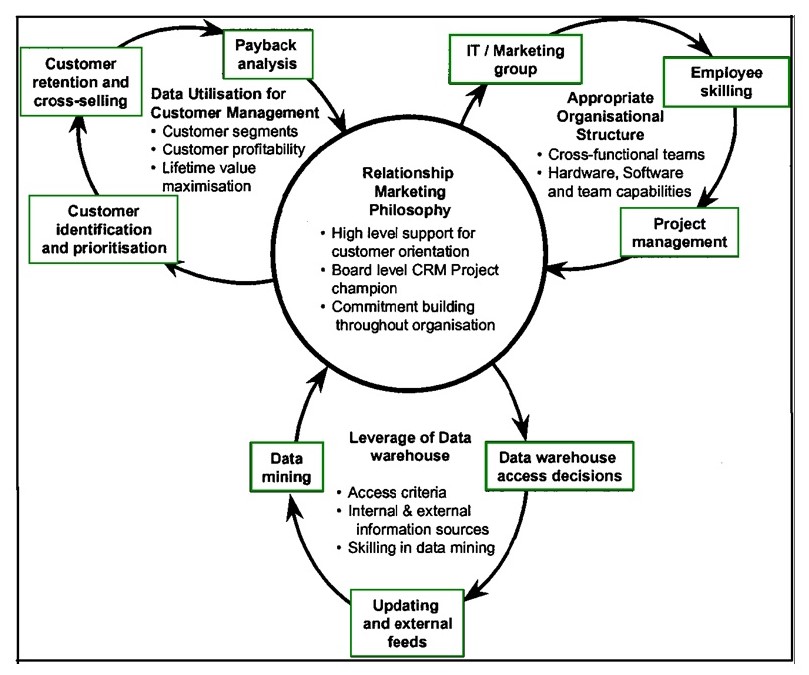
The four essential elements to successfully implementing CRM at any organisation are – relationship marketing, apposite organisational structure, control of data warehousing and data consumption for customer management, all these four elements with their content has illustrated in the above diagram.
Ryals and Payne (2001) added that a framework for CRM execution would take into consideration of all the following four rudiments as where they are necessary for the organisation that intend to implement CRM and this are:
Relationship marketing
The basic principal of CRM has put down on the philosophy of relationship marketing which engrossed with a strong highlighting on the establishment of long-standing rapport with the fitting customers as well as gratitude on the responsibility of Information Technology as an instrument to attain the organisational goals. The Relationship marketing has organised with two prime aim and objectives and these are explicitly to create a centre of attention of customers and to retaining the customers. For this reason, strategies of CRM adoption are the means of way out to attaining the goals triumphant CRM adoption is dependant upon the top management and executive support while CRM accomplishment is a strategic scheme, it must get prior approval and support from the top management (Santoso 2008).
Urbanskienė et al (2008) mentioned that in industrial nations the changes of business progression are outstanding in the direction to the customers while the enterprises pedestal on their course of actions based on the knowledge obtained from analysing the customer’s data rather than upon any suspicions or expectation. Moreover, the movements supported with knowledge of a venture would be potential merely when it has processed the customer’s data in the direction to finding, attracting and maintaining the valued customers.
The continuous changes in the market, non-stop expansion of service addressing the market specialty and overcoming drawbacks of the traditional marketing outset are the grounds to the configuring the new marketing paradigm without analysing the way out to sustaining long standing relationship with potential customers. Due to the continuous change in the market relationship, the new shape of the transformed of competitiveness, carrying out customers’ satisfaction by properly addressing his needs, random interaction with the potential customers in personal level can sustain long standing relationship with customers, suppliers and other marketers.
Organisational Structure
The succeeding feature of CRM adoption is a suitable organisational structure while IT professionals have the well-to-do awareness and understanding in relation to IT integration concerns but they have shortage of marketing capabilities and know how, thus it is essential to set up a cross-functional team integrating IT professionals and marketers as needed. To implement a highly successful CRM framework it is very much important common responsibilities, vision among the all members of team surrounded by the organisation and must have accountability to develop, and put into practice of the complete system including necessary hardware, software, and their application. Marketing executives, as the end user should also be caught up in the designing stage of the whole system, as they would work with the system on a daily basis operation, for this reason, emergent of a user-friendly system can deliver highest outcomes (Martin et al 1995).
Data Warehousing
The influence of data warehousing is the third significant feature to the centre of attention on to effective formation of a triumphant CRM accomplishment where data warehousing is a vital concern that required a wider access to the complete corporate data. From the data warehouse all customers’ ranking, information, and their uniqueness could be achieved to search out the understanding of customers and thus data mining is essential. The Data mining paraphernalia comprised of more than a few analyses to mark out analogous behaviours, outline among a variety of customer sequence to discover the pattern and rapport connecting variables, and recognise their liking choice and preferences (Prahalad et al 2002).
Data utilisation
The foremost significant feature at forth step is to lay emphasis on data utilisation with the objective of customer management. A very sensible approach of each subset of data keen on a database for operation procedure is extremely helpful rather than any very bulky data warehouse as it is incompetent for handling customer data and this procedure is very user friendly for customer management with the intention to identifying, prioritising customers in addition to targeting customer segment fortitude (Dychà 2001).
Limitation of CRM Implementation
Ryals and Payne (2001) addressed that the amalgamation of the above four elements in CRM implementation should support the organisations to get better outcomes in their marking drives as well as business operations though there are a number of obstacles to introducing a CRM system for a particular organisation. These limitations may include as lack of skills, malfunction to appreciate the benefits, insufficient investment, underprivileged quality of data, and poor evaluation structure where the shortage of skills to using the new system is the most significant dilemma of CRM implementation (Peppers & Rogers 2004).
To overcome such limitation, it is essential to engage skilled and practiced consultants those who are sound trained as well as licensed from the software manufacturer and they would be capable to resolve any dilemma rose in the implementation phase. These consultants would be liable to increase the skills of regular end users inside the organisation and build their capability to identifying and resolving features and functionality of the CRM with change management as well as business process (Greenberg 2009).
CRM ERP & SCM
Charkari and Abdolvand (2004) pointed out that the present conscious of the business community has driven them to the quick integration of e-business that potentially renovated the business landscape to a revolutionary transformation. The organizations are struggling with their ERP to put together with SCM and CRM implication to participate and concentrate in the marketplace when all the three approaches are unique but interrelated and not enough easy to integrate though they are not expensive in terms of time and cost (Laudon & Traver, 2002). On the other hand, the expectation of customers, suppliers, as well as employees of the organization have been getting higher and forcing their management to immediate shifting the organization in the direction of e-world and introduce front-office and BPO by means of web based technologies. Thus the present business environment urge to integrating tertiary model of ERP, CRM and SCM under a B2B environment (Shin, 2001).
ERP
Charkari and Abdolvand (2004) also added that ERP system is the foundation, which find out how the business processes would work when the adoption of a CRM strategy necessitates a system where the back office and financial activities of the organisation would be integrated without any malfunction simultaneously with its front office as well as customer-faced course of action. Here it would be troublesome to adopt CRM if the crucial issues are not clear and to be successful, it is essential to have an incorporated approach among the front and back office activities on various levels such as product and service data generation, complete order management, and quality customer service would turn into component of superior information stream.
At the time of assimilating e-application in the Back Office Processes with additionally significant and extensive way, consequently, an e-supply chain would be found in a separated entity, which supports more BPO effectively (Goldenberg 2002). It may not indicate that SCM and CRM jointly lead to ignore ERP but they put more emphasis on ERP, as it can work like a bridge among the different segment. The Relation among SCM, ERP, and CRM has been demonstrated in the following figure:
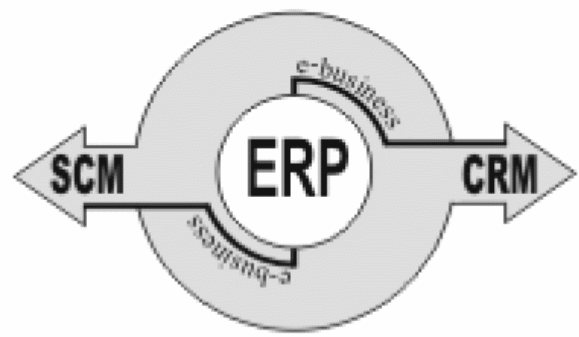
SCM
Prahalad et al (2002) explained that it is most significant to extend the configuration of the innovative business process network essentially automate with updated communications, financial transactions, as well as cooperation within the supply chain partners. It is noticeable that in the modern business environment, no business could manoeuvre like a single entry even though it is a part of complex network of different entries, which utilize internet as a power in accumulate, and meting out information exchanges with a very lowest cost. Chernev (2007) suggested that within the organization, SCM should manage every part of process to distribution, supply and trading include the management demand supply as well as inbound logistics, outbound shipments along with direct and indirect procurement while CRM engage its effort to acquire and retain its valued customers and act as an information gateway.
CRM & Change Management
Kanellakis (2005) pointed out that the technological elements would be considered as the prime catalyst of CRM implementation and its success while the subsequent factor of the CRM implementation and accomplishment is the business strategy of the organisation aw well as its business process management. Charkari & Abdolvand (2004) argued that the foremost enabler of CRM accomplishment is the people, organisational culture, and its business process where change management act as a driving force.
Thompson (2006) added that successfully carrying out CRM would engross the business process as well as change management rather than the aptitude to hook up the system and the change management endow with the most suitable management strategy to channel up planning and implementation of a successful CRM and the change management is the essential factor of success and failure. Change management procedures continuous planning and the awareness of thoughtful changes in product lines, and process to meet the changing market demands and test of customers (Hitt et al 2001). While the management restructure its strategy to getting differential advantage and managing organizational change, essentially the people also change vies versa and it is the most significant challenge for the change management to uphold the higher level of service (Robbins & Coulter, 2003).
Kanellakis (2005) explained that change management grants to engage the most apposite business process strategy to carry out victorious planning of a CRM execution without disturbing the ongoing business process but acts under an environment where change is an approach of life and technology endorse the changes with a grand rapidity. Stoner et al (2006) suggested to forming a steering committee to execute CRM that manage the cross-functional areas of the organisation, convey regular updates, and communicate with major corporate initiatives including assessing the progression and budget.
CRM in Automobile Industry
SAP AG (2005) added that the players of automobile industry are continuously emphasising on how to expand its competitive perimeter by learning from their customers and renovating that gathered knowledge into victorious marketing strategies for their future growth. The environment of the automobile industry becoming gradually more complicated and competitive that differentiate the industry with challenges of competitive profit margins for the new entrants with new automobiles and related after sales services while the OEMs and auto dealers are assertively addressing on CRM to draw attention of new customers. CRM in automobile industry involved to increasing brand loyalty, trim down marketing costs, boost efficiency, and preserve their competitive advantage (Porter, 2004).
The concurrent automotive consumers are progressively better informed about the market and have an extraordinary altitude of choice while customer loyalty has no more forward-looking approach in the automobile industry and thus the auto manufacturers and traders have to work hard to gain and retain customers. To communicate with the high customer expectations, auto manufacturers and traders are eager to employ CRM to ensure effectual marketing boosted sales and quality customer service.
Research Methodology
Research Methodology
Malhotra (2009, p. 9), and Sekaran (2006) provided six steps for marketing research process and Yin (2003) described the case study approach. Yin (2002, p. 5-6) pointed out that if research questions concentrate mainly on “what” question then case study would be a disadvantageous strategy. In this paper, the researcher will follow six major steps to formulate the dissertation, such as the first two steps are problem definition and development of an approach. However, the most difficult steps are research design and fieldwork or primary data collection. Finally, researcher will remove all errors and analysis these data and represent his findings.
Research Approach
Malhotra (2009) and Saunders, Thornhill & Lewis (2006) pointed out that there are mainly two research approaches, such as, qualitative and quantitative. Here it is important to mention that the researcher will apply both qualitative and quantitative research while the quantitative research is significant to gather primary data through interview. For this dissertation, the researcher will apply both techniques for finding the problems but the researcher will keep equal attention on qualitative approach. In addition, quantitative techniques have applicability though CRM is not a numeric concept to test and the researcher design few questions, which required descriptive analysis. As a result, the researcher will apply interview and observation method to collect primary data for evaluation the effectiveness of CRM system of BMW (UK).
Reason to use qualitative and quantitative method
The customers of BMW are more interested to express their opinion rather simply marking the questions. As a result, the researcher has designed the questions by providing both subjective and objective options, for example, respondents have to answer twenty objective questions, where they will get the opportunity to share their experience or recommend their suggestions. According to the view of Marshall & Rossman (1999), quantitative research provides the fundamental understanding of peoples’ language, perceptions, and values to solve the marketing research problem. On the other hand, researcher will undertake qualitative approach to define the problem and quantitative techniques will apply to quantify the data and to recommend a final course of action (Miles & Huberman, 1994) and (Mouly, 1978).
Primary research – Research Strategy
Yin (2003) and Malhotra (2009) mentioned that the primary data originated by the researcher for the definite reason of addressing the research problem by implementing all six steps and obtaining these data can be expensive and time consuming. Saunders, Thornhill & Lewis (2006) also addressed the difference between primary and secondary data by stating that primary data collection is a time consuming matter. In order to collect primary data from the customers of BMW (UK), the researcher of this dissertation has designed a questionnaire and selected interviewing methods. In this case, the researcher will gather primary data from the focus group and the customers of BMW is potential focus group here. However, customers will be competent for interview if his age between 16 to 56 years. Finally, the researcher will use Microsoft Excel to generate diagrams from collected data.
The Interviews
For face-to-face interview, the researcher has divided interview session into several segments, such as:
- Introduction: Initially researcher will ask few common questions regarding the interviewee and then he will proceed on fundamental problems.
- General conversation: In this stage, the researcher will serve the questionnaire to interviewees to know their opinion on CRM influence for increasing the rate of customer satisfaction and discussion over this information.
- Finishing: Consists of asking for additional data and literature source personal perception towards the interview.
The researcher has selected three different places (London, Bristol, and Manchester) to take the view of the customers of different locations. Besides face-to-face interview, the researcher uses some other options because it is not possible for researcher to go all selected locations.
- Telephone and e-mail: the researcher will take the support of technology, such as, telephone and e-mail.
- Observation: Though sometimes researchers use observation method for data collection to save time but observation method only considered for company analysis.
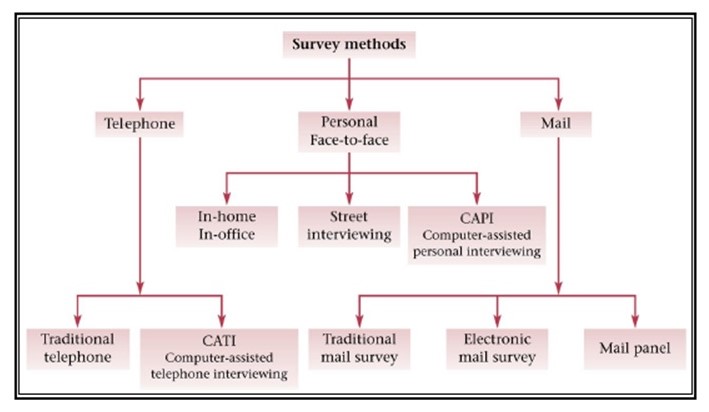
Data Analysis
This researcher would scrutinise when all the data has been collected, once more time all the irrelevant information and inappropriate data will be excluded to ensure more refine and not to encounter a bias about the data quality. The left over refined data will be checked up, evaluated, and compared with previous driven similar research in order to compare and contrast the data this study would use Microsoft Excel for further analysis.
Contingency Plans
To overcome any uneven or disastrous circumstances, this research would employ the contingency plan, while the composed data from the interview would not work satisfactory enough to analysing and to draw a conclusion, the present research method would be restructured and as previously mentioned a qualitative method of a data collection would be engaged. The research has aimed to adopt primary source of data collection but for any uneven or disastrous situation, under this contingency plan it would use secondary source of data collection. The major motivation for such option is the fact that it will allow the author to carry out the research in shorter time and enables the researcher with an understanding about the perceptions.
Secondary data
The secondary data will be used to compare the CRM position of BMW with other Car manufactures in UK those are increasing their sales by maintaining CRM strategy. At the same time, these data is a reliable source, which will also use to support and modify primary data. Sekaran (2006) and Zikmund (2006) stated that secondary data means processed data for existing purpose. They also pointed out the advantages of secondary data sources, for example, it assists to classify the problem, prepare a suitable research design, and answer specific research question. In addition, it helps to interpret primary data more insightfully and it is easy to gather these data quickly and inexpensively. Skinner & Ivancevich (2003) stated that published statistical data are the great sources of information but the researcher had limited option to adopt these options, as the secondary data has limited option to up to date its content.
For this dissertation, the researcher will use several published book of renowned writers, available research papers, case studies, and management journals as well as management books, relevant research books, and survey reports by another researchers. However, integrated annual reports of BMW have limited scope to supply information regarding CRM of BMW (UK).
Questionnaire Design
Designing a questionnaire for this dissertation is a most important task because the findings chapter would be based on the answers of the respondents. In addition, the author will design a questionnaire to motivate, strengthen, and inspire the respondent to complete the interview as incomplete interviews have limited value and serve no purposes. Malthotra (2009, p. 281) argued that it is quite natural matter that respondent can provide imprecise answers whereas questionnaire would assist to reduce response error.
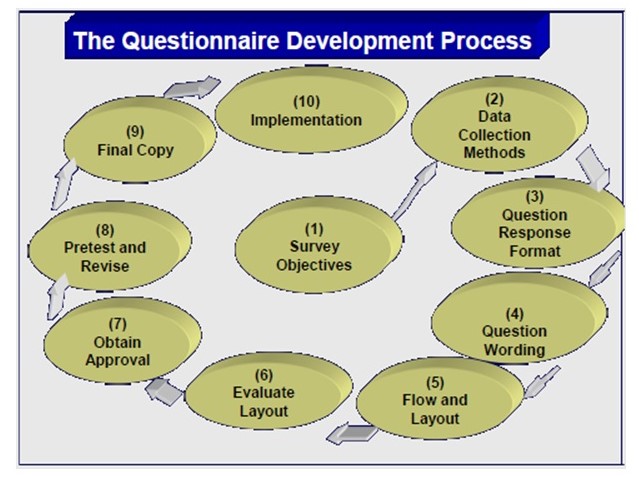
As there are no particular rules to design a questionnaire and it is an art rather than science, the researcher has enough scope to show his ability and skills. In this case, the author has designed the questionnaire considering series of steps, which provided by renowned researcher in their books and research papers. In this case, the researcher will identify the required information regarding customer relationship management and then consider the primary data collection method and prepare the question as well.
However, the author will adopt some steps, such as, identify the objective of the project, select data collection technique, determine the content of questions for this dissertation, prepare the question formation, revise this questions, reproduce this structure and implementation.
Limitation of Data Collection Process
The customers of BMW are too cooperative but their responses have some gap as there involves many internal management issues regarding CRM. In fact, they are not aware about the significance of Data Protection Act 1998; as a result, collected reply from customers would not be fruitful for some questions. On the other hand, the researcher of the dissertation worked hard to collect data from the interested groups as to give answer of 20 questions is time consuming matter.
Findings and Results
The main purpose of this chapter is to analysis the outcomes of the real survey to evaluate the present status and future prospect of the customer relationship management of BMW in UK.
About Customer
Grouping customers by gender
The following graph shows the divisions of sex of the customers, and among 37 respondents, 81% were male and only 19% were female, which demonstrates that the genders of the participants were not proportionally distributed; however, the researcher was not bother about the ethnic background of the respondents.

Grouping customers by age group
The researcher has designed Question three of section A to find out the percentage of participants according to their age. The following figure demonstrates that 33% customers were in the 30 – 45 age group and 30% were between 45 and 55 the range, and 24% customer were above 55 whereas only 5% customers were 18- 25 year olds and 8% customers were 26- 35 year olds.

However, it was a common question to observe the trends of the customer and the significance of this age group composition is that middle age and older people like to purchase BMW car.
Grouping customers by profession
As the price of BMW (UK) product is comparatively high, there is no doubt that all of the participants had a good job but some of them are unemployed person, for example, only 5% were student and 22% were retired person. On the other hand, two the largest group consists of 38% respondents who were service holder and 35% respondents were come from business.
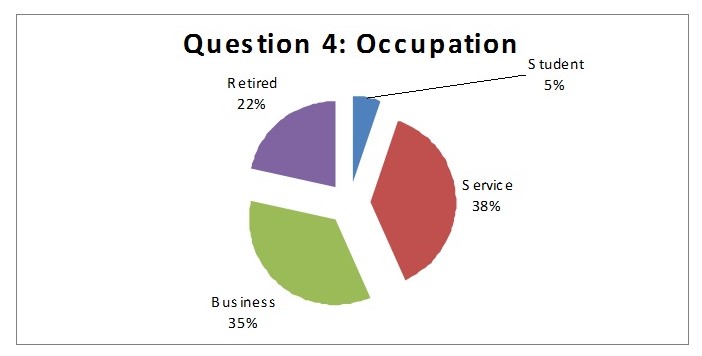
Result: From the data sheet, it can be said that service holder and businesspersons are the major customer of BMW car and they would like to purchase high quality products with high price. As a result, it would be fruitful for the BMW to offer the customer considering their profession, for example, students and retired person are not interested to purchase this brand, so, the management should find out their needs before future communication.
Customer considering income per year
Question 5 is the most important question in section A because this question helps to assess the potential customer of BMW who would have the capacity to be a loyal customer. According to the primary data, the majority of the respondents earned more than £50,001 (18 of total customers) whereas only 3% respondent earned more than £100,000 and only 5% earned less than £30,000 per year. The chart chows that 49% respondents earned £50,001 – £80,000, 19% respondents earned £80,001 – £100,000, and 24% participants earned £30,001 – £50,001.
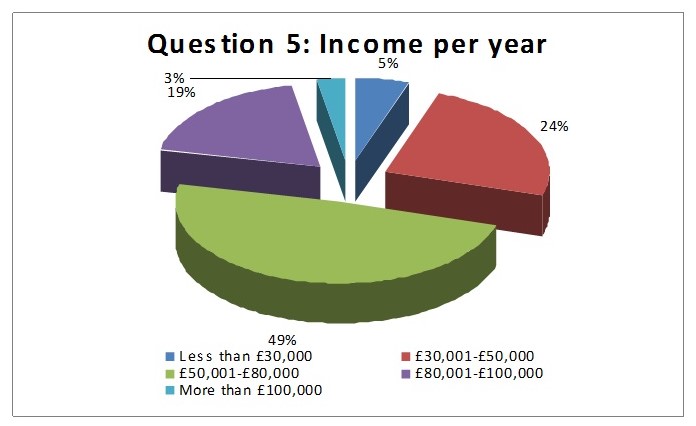
Result: It is essential for a company to have a clear idea about potential customer and this question segmented the customer by income per year. There is no doubt that group C is the prospective group and this result will assist the company not only to upgrade the customer relation but also to fix up the strategy of the company to sustain in the competitive market.
About Customer’s car
Section B of the questionnaire has designed to determine the feature of customers’ car to know about their preference and BMW should identify these issues as CRM focus more on customer service that they will be able to retain more customers.
Customers select the colour of their car
Figure 9 demonstrates that among 37 respondents, 44% respondents said that they were using black car, and 30% respondents were using silver car. At he same time, 14% customers purchase white and 11% customers using grey cars, 5% customer prefer blue but only 3% customer like red and green cars –

From this answer, it is clear that to the UK customers, black (36%) is the most popular colour and they also like other light colours than dark colours, so BMW can increase its production considering customer demand and offer them to purchase new model.
Customers select their preferred model
The survey report shows that among 8 models, highest 40% UK customers like 5 series of BMW for its exclusive design and security options, and 3-series cars are in second position of customer choice as 30% customers like this model. On the other hand, no one customer has Z4 series among 37 customers, only 3% respondent has 6 and 7 series model, 5% respondents have X-series, 8% customers have 1-series and 11% customers have M-series cars.
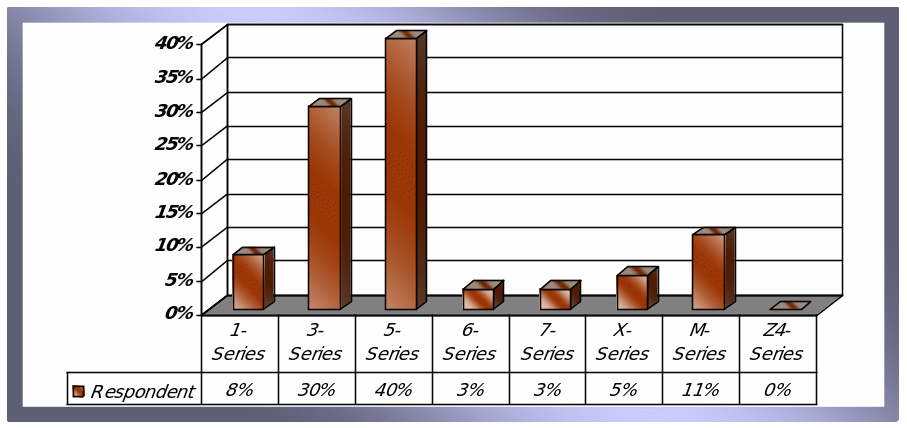
The researcher has designed the question to compare the market demands among BMW cars and 5-series was best to customers in terms of comforts, space, safety, outstanding steering, and other parts. In this circumstance, BMW (UK) should increase budget for marketing unpopular brands and it can campaign to hold the image of 5-series cars by using CRM solutions.
The type of customers’ vehicle
It was a straightforward question and 44% respondents said that they use 4-door cars, 24% respondents purchase Coupé, 19% respondents use Convertible and only 8% respondents choose option Hatched-Back and only 5% select Estate.

It is quite natural that most of the customer would select 4-door as 40% customer use 5-series. As market is competitive, BMW (UK) are continuing to find new requirements to provide better customer service for their customers and this survey will influence the company to offer 4-door car in future.
Why do the customers prefer to use BMW
From the answer of the respondent, the researcher of this dissertation intended to find out the actual reason to use BMW car. However, according to the survey report, 26% of UK based customer said that driving experience has influenced them to use this brand. On the other hand, only 8% of the customers consider the price of BMW car and 14% use it as a status symbol and safety purpose. Both design and performance are important to customers as 16% of respondent consider these issues respectively.

Result: It is necessary to evaluate customer’s demand in order to maintain a good relation with customers and get fruitful result from CRM process. The price of BMW products is comparatively higher than its competitor’s price as its design and technology varies model to model, so price is not a major factor to purchase BMW but some people like high price to demonstrate their financial status. The ultimate result of the question is that customers are using BMW for specialty on design, safety, performance, and driving experience, which indicates buyers like good quality products, so, the management of CRM should highlight on quality issues when contacting with customers.
BMW contacted with customers frequently regarding its new product information, promotion etc.
More than 50% respondents said that BMW contacted with them frequently but 10 customers disagree with this statement and four customers have no comments in this aspect.

Result: BMW (2010) stated that BMW only communicate with old customs but they provide necessary information to a new customer if they have any inquiry about the products or services. However, the results confirm the gap in CRM system as BMW not always contacted with customers regarding its new product information, and promotion, so, it should concentrate on this issue.
Customers are clear about the promotion and price that BMW’s Customer Services offer
Most of the customers are clearly understand the offer, for example, 62% respondents have no confusion about offer, 8% have never realize the offer, and only 19% respondents have not clarity about the price of BMW.
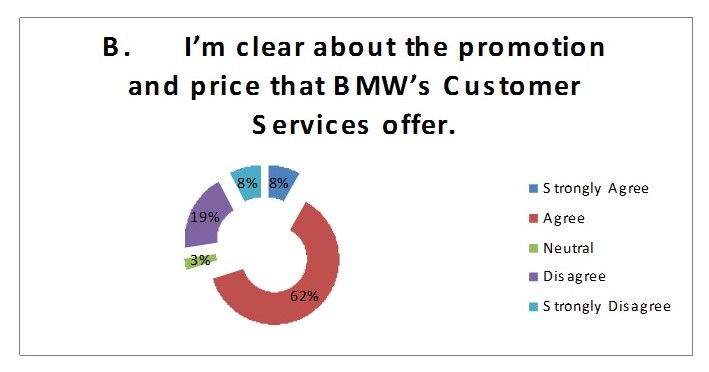
Result: mostly promotional materials and pricing offer of BMW can communicate with the customers, but sometimes it is difficult for the customers to make any clear understanding and perception.
Customers are always provided with options by BMW’s Customer Relations on the services
About 49% of the respondents were agree, 5% were strongly agree and disagree respectively, 19% were neutral and 22% were disagree with this statement.
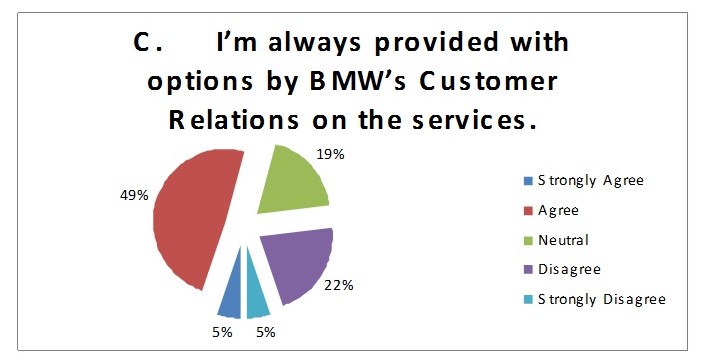
Result: Not all customers of BMW get Customer relation offering from the company. More than half of the customers kept out of touch from the company. BMW needs to update its customer’s database with their current address.
While receiving services from BMW, Customers are listed on a long waiting list
Among the 37 BMW car users, 45% customers were agree, 14% were disagree and 14% were strongly disagree, and 24% were impartial with this statement.

Result: To get services from BMW, customers need to wait in a long queue and customers have to suffer wasting their valued time. BMW needs to extend its service centres.
The customers are provided with a replacement car during a major service
It is a vital question to know about real position the customer service, however, among 37 users, 17 customers were agree, 4 customer were strongly agree, 4 were neutral and 15 were disagree that indicates BMW cannot provide replacement in every situation.
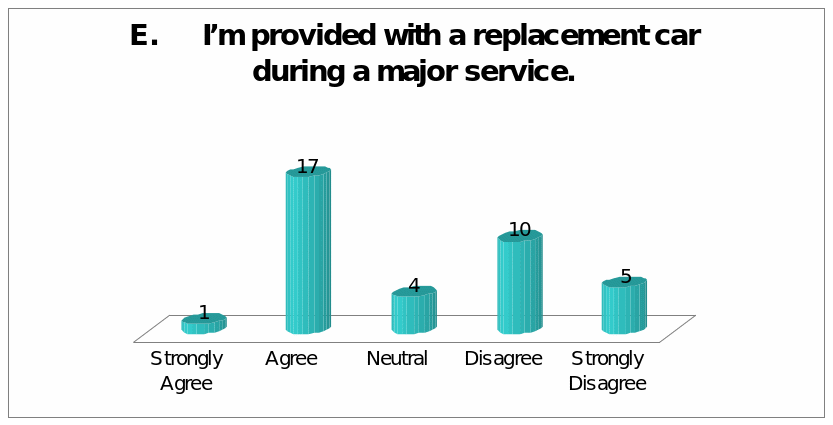
Result: At the time of purchasing, BMW guarantees replacement and repair within a particular timeframe but in practically they ask for mileage used within the duration and disagree to provide any service. In that circumstance, the customers lost their trust when they refuse for replacement or repair, as a result the answers from the customers was varies.
Customers get updates of their car while it is in service
A substantial number of the respondents (48 %) never got updates of their car while it is in service but 30% have no opinion and only 17% gets updates.

Result: This question raised another loophole of its customer service because BMW does not provide any regular feedback when the vehicle in BMW’s workshop or local service centre and thus customers become anxious and think to go paid up workshops rather than the BMW’s free service.
Customers feel comfortable in asking for services from BMW
From the feedback of this question, the researcher of this dissertation finds that 73% customers were agree, 14% were strongly agree , 5% were disagree, and 5% were strongly disagree with the statement and 5% have no opinion.

Result: the result shows that BMW has established strong image successfully to the customers’ mind by providing a pleasant service experience. BMW provides customers service more than they expected, for example, all the members of BMW are polite, and attentive to the customer, they honestly and quickly handle customer’s problems, and it provides equal concentration for both direct and indirect customers.
However, 8% of total respondent said select the option other because lack of knowledge, have no experience or have personal limitation in this aspect as they never asked for service to BMW.
While communicating with Customer, BMW tries all media of communications
BMW inserts personal information about customers such as their phone number, address, and email address in a computer and BMW tries all media of communications by using several tools. However, 56% customers were agree, 11% were strongly agree , 11% were disagree, and 3% were strongly disagree with the statement and 19% were neutral.
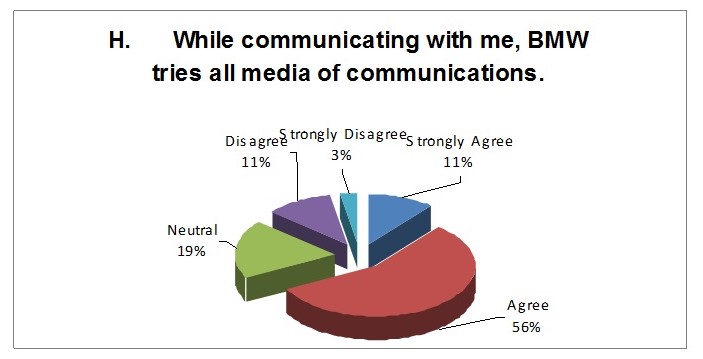
Result: BMW’s media strategy demonstrates more than half of its effectiveness to communicate and selection of media. It needs to add more value to its media strategy.
To get a quicker service Customer would prefer local service stations than BMW service centres
Figure 21 demonstrates that 5 respondents strongly believed that local service is better, 11 customers were simply agree with this statement and 2 has no opinion. However, 17 customers strongly disagreed, and 2 customers strongly disagreed with this statement that indicates 51% customers prefer BMW service centres.
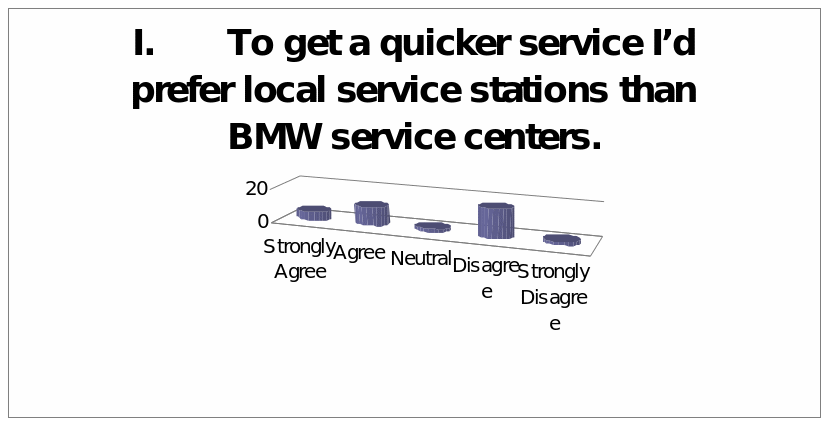
Result: the respondents did not support the statement, as most of them would prefer BMW service centre to get quicker service.
Customer will recommend BMW to others
According to the survey, 25 customers or 67% customers said that they would recommend BMW to others, 19% customers agree, only one customer disagree with this statement and 11% customers were neutral in this issue.

Result: As most of the customers are highly satisfied with the BMW cars and after sales services, most of the customers will suggest other people to purchase BMW, which will help to increase sales.
Discussion
The CRM of BMW starts long before the production of the new automobile as developing new car requires substantial research on the demand and quality of the car (Winer, 2001). The CRM approach taken by BMW in 1999 and from that time to till today it is an important function of the company to build its brand in the market through customer satisfaction. In UK, following activities have taken by BMW to satisfy its customer and conduct CRM.
Building a Customer Database
Building a customer database is the initial activities for BMW UK to establish their relationship with the customers. It contains the full data and history of the customer through which it can assess the customers. Previously it had done through physical contact and over telephone (ESVP 21, 2005). However, currently BMW has strong network and IT infrastructure for collecting the customer data and conducting CRM. In this step, BMW primarily collects the following data on customers.
- Transaction details: BMW gathers all the data regarding the past purchase of the customer including the purchase habit, payment habit, payment mode etc. (BMW, 2010)
- Customer address: BMW gathers information regarding the detail address of the customers to find out and contact the customers. It also identifies the purchase point of the customer where the customer previously made his or her purchase.
- Customer Preference: BMW gathers information on the choice of the customer regarding the automobile. This includes the preference expressed by the customers previously (BMW, 2010).
- Marketing response: The data gathers by BMW regarding the marketing response includes the response rate of customer to different marketing efforts. Some customers influence by the advertisement, some prefer the direct sale offer and some other like the promotional offer.
BMW currently uses the application of Siebel Systems to gather information about the customers. The financial service made by the BMW group also serves as a means for collecting the data of customers. After collecting the data on the customers, BMW creates a full database of its customers for analyzing the customers demand and other issues.
Data Analysis
The main aim of analysis of the data from the database is to identify the different pattern of customers and group them to different segment for selling purpose. However, in modern time the concept has changed and currently, especially in case of BMW UK, the concentration on each customer is very important. BMW uses the modern concept of Life Time Customer Value (LCV) that implies analyzing each customer in term of current and future profitability. Here the profit generated from each customer calculated against the cost of obtaining the customer and it figured in the analysis. After that, the marketing manager decides which customer needs to give attention for future profit of the company, and which customer should give less attention (Schmarzo & Harper, 1999). BMW uses this technique for retaining the customers for the long time. As all of the business of BMW done through the dealers, it is very important to generate the information regarding the customers to the dealers so that they can take action accordingly. BMW also considers the volume of purchase of the customers and using the application system, it calculates the customers how many times enter the site of the company for purchase and for other information (Caly, 2006).
Customer Identification
After analyzing the customer database, BMW selects its target customers for addressing the marketing and sales efforts. Whenever selecting the customers, it is generally assumed that the customers are those who sitting behind the steering of the car. However, the philosophy of BMW regarding customer selection is different. Not all the time the person drive the car makes the purchase decision, sometime the decision maker is a person different from the driver. BMW address those people who directly influence or make the purchase decision such as the CEO of a company makes the decision of purchasing car for the company. The higher purchase potential customers are important for the company and BMW takes marketing program to retain this customers. Sometime, some loyal customer has good profit potential but purchase car very recently. In such a case the less attractive customer are also selecting for the retention program (University Dissertations, 2010). It is very important for the part of the CRM of BMW to retain its customer as well as increase the profitability.
Relationship Measure
BMW identifies the target customers in the previous steps and at this step; it tries to build long-term relationship with its customers. The company uses following techniques to maintain relationship with the customers.
- Customer service: BMW provides high quality service to the customer, which includes both sale, and after sale services. It provides insurance, loan, and other facilities to the customers when buying the car from BMW.
- Loyalty reward: According to this program, BMW gives award to the loyal customers who frequently buy car from BMW through price concession and other incentives. Beside this, company also provides free after sale service and free original parts to the loyal customers and sometime made the arrangement for selling their old car
- Customization: Customization is very common issues in automobile industry and BMW places importance to each customer so that it can provide customize car to the customer. Instead of mass customization, BMW focus on each customer’s demand and serve him or her accordingly.
- Privacy: The rapid enlargement of IT give raises the question of security of the individual in the cyber world. BMW uses an application system that serves the entire unit of the company and increases the tension on security of the data of the customers. As a result, BMW executes a contract with Siebel Systems for easing the job of the company and protect the data of the customers. It uses the data of the customer for sales and other forecasts and as a result, the data do not transmit anywhere.
- Community: BMW gives the customer the opportunity to build community for expressing their loving to the car of the company. As a result, a number of people can share and discuss about the product of BMW, its service and other issues. It helps to increase the sales and take the feedback from the customers directly.
The overall CRM of BMW not only address on the end customer who buy the car but also the dealer and other stakeholders of the organization who jointly build the CRM system of the company. These issues are as follows.
- Plan and Production: This department of BMW collects the data from the customers about their choice and preference to produce the car and sometimes the product may be customize car for specific customer. It also takes feedback on the previous production and level of satisfaction of customers regarding the purchased car.
- Corporate Client: A substantial amount of revenue of BMW comes form the corporate sales in UK, which demands special attention of the company. Therefore, BMW builds a CRM system for corporate client with a special team working for developing and retaining these types of client.
- Dealership management: All of the automobile of BMW sales through the dealer outlets and BMW mainly focus on customer through the dealers of the UK. BMW trains the dealers for providing better services to the customers. It receives and provides the data on customers from and to the dealer point so that they can understand the customers.
- Call centre: BMW has well developed call centre for the customers and any customer can ask any question regarding the company and product through the call centre. Generally, customer when buying a car wishes to express their felling to the company about the product, which they buy. Therefore, BMW through its call centre receive the feedback form the customers and give direction or suggestion to the customers.
- Reselling car: BMW provides facilities of resell the BMW car by the customers, which helps the customer to find a new model for them. This service is very popular in UK where a customer can listed with BMW for selling their existing BMW car and can buy a new model of the car. It is also useful for those who do not have enough money to buy a new car. BMW provides new motor parts to the customer if necessary and it with less charge to the loyal customer of the company.
How effective is BMW’s CRM strategy in communicating with its customers?
Customer Satisfaction
One of the most important components of CRM is the level of customer satisfaction that yields the success of CRM program to the company (Docstoc, 2010). Nakao (1972) and Leggett, (1999) stated that Ford pinto had failed to satisfy the customers because the product was poor quality. In case of BMW, the customer shows mixed reaction about their satisfaction to the company. Firstly, ten of the twenty participants shows higher level of satisfaction with BMW as they are happy to use the BMW car and the post sale service are satisfactory to them. Secondly, four participants show moderate level of satisfaction with the company, they are not highly satisfied and dissatisfied with BMW. They say the after sales service of BMW was not that much satisfactory but using the car is feeling good. Thirdly, six participants dissatisfied with BMW, as because, they do not feel good to use the car and the after sale service also not up to the expected level. One participant share his experience where he said that the response to the problem of the customer is not prompt and he have to wait for more than one month to get feedback from the company about his problem. On the other hand, the satisfied customers said that they receive quick response from BMW about their problem and the company monitors their problem cordially. Generally, customer after buying the car wants to share their experience of using the car with the company and BMW is not able to concentrate equally on all of the customers. It is one of the major problems of the company regarding efficient management of CRM.

Response to the Customer
The response rates of BMW to the customers are not very good as most of the customer address on this issues. However, BMW claims that, they quickly response to the customer demand but the dealers make the late. The sale of BMW car solely done by the dealer and customer buy car from the dealer point. At the same time, the after-sale service also provided from the sales point where the customer buy the car. As a result, the process takes more time as the dealer address the problem to the company and the company gives the service through the dealer point. To reduce the problem BMW currently use advance database software and call centre to response to the customer quickly. According to this software, all the information regarding the customers are available in every point of selling and a team working on the issues and visit the dealer outlet to improve the service. In the customer survey in UK, 65% of the participants believe that the response to the customer by BMW is late and it negatively affect the loyalty of the customers and only 20% believe that the response of the company to the customer is quick and 15% believe that the response was moderates. From these finding it is clear that the response of BMW to the customer is not satisfactory.
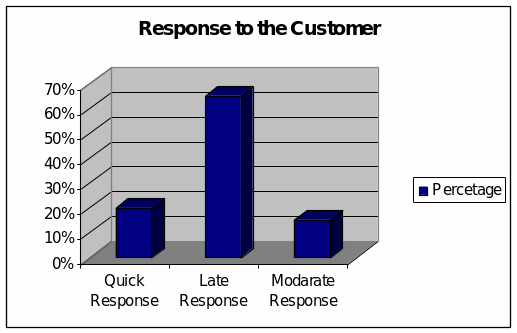
Product Quality and Design
The quality and design of the product is very important from CRM point of view as if the quality of the product does not match with the expectation of customer than the relationship will not going well. BMW produces premium car for the customers where the quality and design is very important to attract the customers. As a result, the company uses huge investment on R&D to develop new and quality car for the customers. Generally, the customers of BMW happy with the quality and design of the car they buy. Approximately 50% of customer thinks that the quality of the car is best and the design is alike, whereas 30% of the customers believe that the quality and design of BMW car is better and 15% of the participants believe that the quality and design of the car is good. Finally, only 5% of the customers believe that the quality and design of the car in not good. From this analysis, it is clear that the product quality and design is very good and customers are satisfied with current product portfolio of BMW.
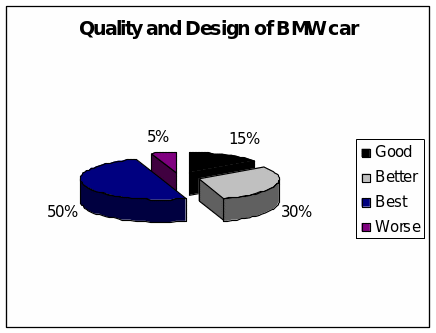
Communication
Communication with the customers is very important for organization where the product is supreme in quality and price. BMW follows a communication strategy where the company treats every customer separately and communicates with each customer to send massage of the company regarding new product or services and all other issues. Beside this, the company has a 24-hour call centre and web facilities through which BMW as well as the customer can communicate with the company. The company took the data of the preferences of the individual customer and remind the customer if such kind of automobiles available in the outlet. BMW also communicates with the customers through various types of advertisement using various medium including the website, cable, print etc. Nevertheless, BMW cannot able to maintain communication with every customer due to some limitation. Most of the customers of BMW satisfied with the communication strategies and they felt happy to know more about various activities of the company.
Sale and Resale
BMW provides the facilities to the customers to sell their old car to buy a new model from the company. It operates a website where a customer can sell an old car and buy another new or old car. The company gives guarantee for the selling car and provides spear parts to the buyer if necessary. Customers are much delighted about these services of BMW where they get the chance to sell their old car and buy a new one. On the other hand, some may not have the ability to buy a new car easily can buy car from this arrangement. Most of the customers express their satisfaction regarding this buying and selling services of old car by BMW.
Ancillary Service
BMW provides facilities like fan clubs, magazines etc to the customers, which they enjoy very much. Beside this, BMW generates new parts for its existing model that a customers can easily buy from the dealer to replace the old part of the car. Almost the entire customer likes these services of BMW. Through the website of fan club and magazine, the customer can express their feeling about the company and the company can get the knowledge about its customers.
What is BMW’s position in terms of CRM compared to their Industry rivals?
The main competitors of BMW in UK includes General Motor (GM), Mercedes-Benz, Daimler AG, Volkswagen Group United Kingdom Limited, Honda, Toyota, Nissan, Ford, Alfa Romeo etc. All of the competitors have CRM program addresses mainly to retain old customers and develop new customers for the company (GM Corporation, 2009). In UK market, the share of BMW is lower than that of competitors, which implies the CRM of BMW is inferior to the competitors. The relation with the customers reflected in the sales volume of the company. Those Companies that able to develop good relation with the customers enjoys the increased level of sales. Market share, profit trends, number of car sales etc also indicate the success of CRM of the organization (Maklan, Knox & Peppard, 2007).
Number of car sales
In the year 2009, Ford company able to earn highest revenue through selling the maximum number of car in UK market. In contrast, BMW possess the sixth position in selling the car, which explains the poor condition of CRM of the company because all top ten company produces premium car so that the quality does not vary at an extreme level. The relationship of Ford with the customer is stronger than BMW in UK, which exhibits in the sales and profit.
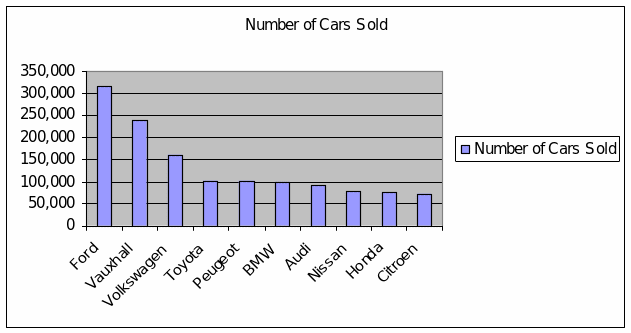
Actually, all the programs taken by the firms even the CSR targeted to boost the sales of the company for manufacturing firms and CRM is not exception to those initiatives. The main aim of the CRM is to maintain the good relation with the customers and retain them so that other company do not get chance to occupy them. CRM of the company directly affect the sales volume of the company as if the relation with the customer are good then these customer brought themselves the product or even serve as a referee for other to buy the product. Therefore, the sales volume and market share of the company reflects the success rate as well as customer retention rate of the company though it may not figure out the exact rate of retention.
Market Share
Like the total number of sales, the total market share of Ford in the UK is highest as it grabs 15.86% of total market. On the other hand, BMW possess only 4.95% of the total market and possess sixth position in the market regarding the market share. Ford’s customer service software develops by Microsoft and IBM that enables the company to monitor more closely the customers and helps to build strong relationship with customers (Grassroots, 2010). GM also has a good relationship with the customers and it able to hold market share of 11.92% in UK automobile market.
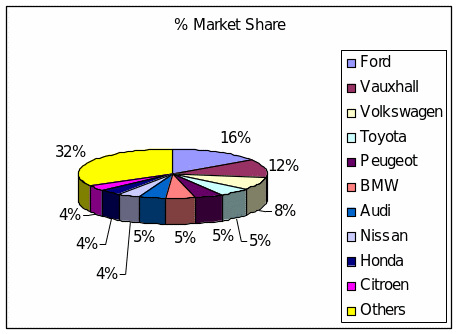
Profit level
In the year 2009, most of the UK automobile companies suffer decrease level of profit from the previous year including BMW, Ford, GM, Honda etc. Most of these companies also lost the market share as well (Mearns, 2010). The reason behind the losing profit may be the economic downturn experienced by the western world but during this situation company like Ford, GM etc face only little shakes. On the other hand, BMW loss 12.77% market share in the year 2009 which not all because of the downturn but the weakness of the CRM system as it does not able to maintain strong relationship with the customers (IMI Research Department, 2009). For this reason, though GM, loss market shares in one brand recover it through other brand in the market.
Response to the Customer
The response to the customer is important to increase the volume of customer, which in turn contribute to the revenue and profit of the company. BMW is less responsive to the market especially in the year 2009 where customer face economic problem and can not afford high cost car, BMW remain with its luxurious car and loss the customer. One the other hand, GM, Ford etc. response quickly to the market and reduce their car price to motivate the customers and as a result, they divert the customers of BMW to them.
Conclusion
Recommendations
After a thorough analysis of the CRM of BMW and taking feedback from the customers, it appears that there are some major problems in CRM systems of the company, which must need to be rectified to achieve and retain new customers in UK market. Here are some specific recommendations have been developed to guide the future direction of CRM of BMW:
- BMW should develop or adopt more efficient data base system to collect and retrieve data about the customers. It needs to take steps to make the availability of data every time when required. The data should give to the dealer point so that the dealers also can have the idea about the customer of the company, which prompt the services to the customers.
- The call centre of the company needs to be virtual and dynamic to respond to the demand and enquiry of the customers. As there are few dilemma in CRM issues, BMW should open more call centre in UK to enhance the solution of the problem of the customers.
- Company should build a team of employee with strong interpersonal skills to deal with the customers. The customers are happy to talk with person of great interpersonal skills and abilities. This type of person has the ability to convince the customer more vigorously;
- The marketing and communication activities of BMW need to target properly, so that the right person gets the right massage. It is also very useful for developing new customer besides retaining the existing customers.
- The relationship with the dealers must improve by BMW to build strong relationship with the customers (Finlay, 2008). BMW should build a philosophy where the dealer not only focuses on profit but also on the long-term relationship with the customers.
- It should consider the CRM strategies of competitors, for example, Volkswagen took various CRM initiatives to increase sales in competitive market, but these actions fell short of meeting customers’ as well as its own requirements. In order to overcome this critical situation, Volkswagen integrated SAP software, which helps Volkswagen to acquire a comprehensive and consistent view of every customer (Volkswagen, 2009). So, BMW should integrate other related software for the development of data, procedure for sales, complaints management, campaign management, after-sales service, and facilitate the sharing of knowledge and encourage collaboration;
- It should take technological advantages, such as implementation of Microsoft [Dynamics] CRM to increase sales by supporting sales team;
- Public argument cost regarding warranty and many other sorts of customer satisfaction tools.
- This result of this phase would take two distinct shapes either in satisfaction or in dissatisfaction. If the customer satisfied, then he/ she will make good comments about the car to the family and friends. Similarly, dissatisfaction will motivated a customer to react in negative way.
- From the above discussion, it can be said that CRM can be an effective weapon for BMW (UK) to build and improve an excellent relationship with its customers. However, it should find out numerous ways to attract more new customer to increase its sales and it has to try to protect customer attention from rivals CRM strategies, as the competition among competitors is too high.
- BMW should compare its current CRM strategies with other 3PL Companies CRM policies as it is important to have a practical idea about CRM implementation process;
- BMW (2010) stated that it is maintaining relationship with segmented customers or existing customers who may be future potential customers but BMW should implement CRM for the entire customer cycle to increase customer retention and should more importance on older customers as people expect more from CRM;
- Figure 5 shows that only 19% customers are female, so BMW should increase promotion to boost female customer.
- Figure 7 demonstrates 35% customers’ profession is business and figure 8 shows that 49% earn more than £50,001 per year, so BMW should maintain regular contact with these customers as they change the car model frequently;
- The strategy of BMW is effective to retain 4-door car users but it BMW should campaign more to increase sales other products;
- As figure 12 shows that buyers like good quality products, the management team of CRM should highlight on quality issues when contacting with customers;
- Customer’s valuable information can be misused due to technological development or e-marketing process (Lowry & Dignam, 2007). In this context, if BMW UK collects any data from to customer, it should strictly follow the provision of Data Protection Act 1998 and figure 13 shows that BMW frequently contact with existing customers;
- The response of BMW to the customers should make quick to solve the problem of the customers. To reduce the respond time to the customers the company needs to develop efficient operation and train the employee properly to respond quickly to the customers.
- BMW should provide updates to the customers about their car while it is in service to minimise customer’s tension.
Conclusion
BMW has established a strong CRM system in its UK operation and in most cases; the CRM demonstrated higher success for the company. The main activities regarding CRM of BMW include building a strong and resourceful database of customers to address proper customer for the promotion of new car or services. To do so, BMW uses strong software of CRM and run call centre for answering the queries of customers. Beside this, the company runs other services like resell of car, fan clubs, magazine, motor parts etc. for customer satisfaction. The success of CRM largely depends on the performance of the dealers and in case of BMW; the dealers cannot show higher performance to boost up the sales. The competitive position of BMW regarding profit, market share etc is in sixth position whereas Ford and GM possess first and second position. The reason behind this is that the CRM activities and application of CRM software at BMW does not comparable to that of Ford and GM. The customers of BMW in UK also have shown moderately satisfactory impression about the response to the customer’s service and overall satisfaction is not very high.
Reference
Baran, R. Zerres, C. & Zerres, M. (2009) Customer Relationship Management. Web.
BBC (2009) BMW urges UK scrapping incentive. Web.
BBC (2010) Gordon Brown campaigns at Oxford’s BMW Mini factory. Web.
Bekker, H. (2009) The profit and market share of UK automobile market. Web.
Belch, G. E. & Belch, M.A. (2009) Advertising and Promotion. 8th ed. Tata McGraw Hill.
BMW. (2008) Annual report 2008 of BMW. Web.
BMW. (2010) BMW Group in the UK, BMW official website. Web.
BMW (2010) Market for premium vehicles will continue to grow.Web.
Buttle, F. (2008) Customer Relationship Management. 2nd ed. London: Butterworth-Heinemann.
Caly, R. (2006) How BMW Channels Information to Everyone Involved in a Car Purchase: An Interview With Ralf Caly, Customer Think Corporation. Web.
Charkari, N. M. & Abdolvand, N. (2004) A Proposed Model in Integrating SCM, CRM & ERP. Web.
Chernev, A. (2007) Strategic Marketing Analysis. 2nd ed. Brightstar Media.
Docstoc. (2010) BMW GROUP. Web.
DychÃ, J. (2001) The CRM Handbook: A Business Guide to Customer Relationship Management. 1st ed. NY: Addison-Wesley Professional Publisher.
ESVP 21. (2005) Total CRM solution for Automobile Industry. Web.
Finlay, S. (2008) BMW Uses CRM To Aid Service Sales. Web.
GM Corporation. (2009) Form 10-K General Motors Corp – GM. Web.
Goldenberg, B. J. (2002) CRM Automation. 1st ed. London: Prentice Hall.
Grassroots (2010) BMW: Online surveys measure BMW and Mini customer satisfaction. Web.
Greenberg, P. (2009) CRM at the Speed of Light. 4th ed. Delhi: McGraw-Hill.
Hitt, M. A., Ireland, R. D., & Hoskisson, R. E. (2001) Strategic Management. 4th ed. South-Western Thomson Learning.
IMI Research Department. (2009) The Automotive Retail Sector – Impact of the Recession. Web.
Kanellakis, N. (2005) Change Management and Customer Relationship Management (CRM) Implementations: Planning for Success. Web.
Keller, K. L. (2009) Strategic Brand Management- Building, Measuring and Managing Brand Equity. 3rd ed. New Delhi: Prentice Hall of India.
Kotler, P. & Armstrong, G. (2006) Principles of Marketing. 16th ed. Prentice-Hall of India Private Limited.
Kotler, P. & Keller, K. L. (2006) Marketing management. 12th ed. New Jersey: Pearson Prentice Hall.
Laudon, K. C., & Traver, C. G. (2002) E- commerce- Business, Technology, Society. 4th ed. Dorling Kindersley Pvt. Ltd.
Leggett, C. (1999) The Ford Pinto Case: The Valuation Of Life As It Applies To The Negligence-Efficiency Argument. Web.
Lowry, J. & Dignam, A. (2007) Company Law. 4th ed. London: Oxford University Press.
Maklan S. Knox S. & Peppard J. (2007) The Missing Link of CRM Profitability: Building Marketing Capabilities. Web.
Malhotra, N. K. (2009) Marketing Research- An Applied Orientation. 5th ed. Prentice-Hall of India Private Limited.
Marshall, C. & Rossman, G., (1999) Designing qualitative research. 3rd ed. Thousand Oaks – CA: Sage.
Martin, C., Clark, M., Peck. H. & Payne, A. (1995) Relationship Marketing for Competitive Advantage: Winning and Keeping Customers. 1st ed. London: Butterworth-Heinemann
Mearns, E. (2010) UK new car sales and the recession. Web.
Miles, M. & Huberman, M. (1994) Qualitative Data Analysis. 2nd ed. Beverly Hills, CA: Sage.
Mouly, G. J. (1978) Educational Research: The Art and Science of Investigation. Boston, MA: Allyn & Bacon.
Nakao, M., (1972) Ford Pinto Collision Fire. Web.
Pearce II, J.A. & Robinson, R.B. (2006) Strategic Management. 8th ed. London: McGraw-Hill.
Pearson. (2009) What is CRM and Why is it Important? Web.
Pelland, T. (2007) Customer Service A Revolutionary Change. Journal of the Quality Assurance Institute, Vol. 21, Issue- 2.
Peppers, D. & Rogers, M. (2004) Managing Customer Relationships: A Strategic Framework. 1st ed. London: Wiley.
Porter, M. E. (2004) Competitive Strategy. Export Edition. New York: The Free Press.
Prahalad, C. K. et al. (2002) Harvard Business Review on Customer Relationship Management. 1st ed. Oxford: Harvard Business Press.
Robbins, S.P. & Coulter, M. (2003) Management. 7th ed. New Delhi: Prentice Hall.
Ryals, L. & Payne, A. (2001) Customer relationship management in financial services: towards information-enabled relationship marketing. Journal of Strategic Marketing, Vol. 9. Web.
Ryals, L. (2009) Creating Value through Customers. Web.
Santoso, L. W. (2008) CRM Adoption Framework and Its Success Measurement.Web.
SAP AG (2005) Customer Relationship Management in the Automotive Industry. Web.
Saunders, M., Thornhill, A. & Lewis., P. (2006) Research Methods for Business Students. 4th ed. London: FT Prentice Hall.
Schmarzo, B. & Harper D. (1999) Making Every Customer Relationship Count, Sequent Computer Systems.Web.
Sekaran, U. (2006) Research Method for Business. 4th ed. John Wiley & Sons, Inc.
Shin, N., (2001) Strategies for Competitive Advantage in Electronic Commerce. Journal of Electronic Commerce Research, Vol. 2, No. 4.
Skinner, S. J., & Ivancevich, J. M. (2003) Business for the 21st Century. Boston: Homewood.
Stoner, J. A. F., Freeman, R. E., & Gilbert, D. R. (2006) Management. 6th ed. Delhi: Prentice-Hall.
Thompson, B. (2006) Top Trends in Customer Relationship Management. CRM Association Journal, Netherlands
Thompson, A. et al. (2007) Strategic Management. 13th ed. New Delhi: Tata McGraw- Hill Publishing Company limited.
University Dissertations. (2010) How can BMW improve its position in the UK Market through the launch of the 1 and 3 series, University Dissertation. Web.
Urbanskienė, R. et al. (2008) The Model of Creation of Customer Relationship Management (CRM) System. Web.
Vasile, A. (2009) BMW Group Announces 2009 Earnings. Web.
Vogt, D. (2005) Congressional research reports: Direct-to-consumer advertising of prescription drugs. Web.
Volkswagen (2009) SAP Customer Success Story Automotive – Manufacturer: Volkswagen. Web.
Ward, A (2002) Understanding CRM. Web.
Winer, R. S. (2001) A Framework for Customer Relationship Management. Web.
Yin, R. K. (2003) Case Study Research: Design and Methods. 3rd ed. Beverly Hills, CA: Sage.
Zikmund, W. M. (2006) Business Research Methods. 7th ed. Orlando: Harcourt Publishers.
Appendix 1
Questionnaire
Questionnaire for BMW
Thank you for participating in the survey. The questionnaire is a part of my dissertation, a requirement of my MBA program I’m enrolled in. your response and details will be used only for the purpose mentioned below and will not be disclosed.
Aim
The aim of this questionnaire is to assess the present status and future prospect of the customer relationship management of BMW in UK.
Objectives
- To finding the process of conducting CRM by BMW,
- Assessing the effectiveness CRM strategy of BMW to communicating with customers
Section A: (About me)
Your name: ______________________________
Please select your sex: Male [ ] Female [ ]
Please select you age (years) group: 18-25 [ ] 26-35 [ ] 36-45 [ ] 46-55 [ ] +55 [ ]
Please select your profession: Student [ ] Service [ ] Business [ ] Retired [ ]
Please mention your income per year group: Less than £30,000 [ ] £30,001 – £50,000 [ ] £50,001 – £80,000 [ ] £80,001- £100,000 [ ] More than £100,000 [ ]
Section B: (About my car)
Your Registration Number: _________________________
Please select the colour of your car: White [ ] Black [ ] Silver [ ] Grey [ ] Blue [ ] Red [ ] Green [ ]
Please select your car’s model from the following: 1 Series [ ] 3 Series [ ] 5 Series [ ] 6 Series [ ] 7 Series [ ] X Series [ ] M Series [ ] Z4 Series [ ]
Please also mention the type of your vehicle: 4-Door [ ] Coupé [ ] Convertible [ ] Hatched-Back [ ] Estate [ ]
Why do you prefer to use BMW? Design [ ] Performance [ ] Status Symbol [ ] Price [ ] Safety [ ] Driving Experience [ ]
Please state to the level you agree or disagree with the following statements:________________________________
BMW contacted me frequently regarding its new product information, promotion etc. Strongly Agree [ ] Agree [ ] Neutral [ ] Disagree [ ] Strongly Disagree [ ]
I’m clear about the promotion and price that BMW’s Customer Services offer. Strongly Agree [ ] II. Agree [ ] III. Neutral [ ] IV. Disagree [ ] V. Strongly Disagree [ ]
I’m always provided with options by BMW’s Customer Relations on the services. Strongly Agree [ ] Agree [ ] Neutral [ ] Disagree [ ] Strongly Disagree [ ]
While receiving services from BMW, I’m listed on a long waiting list. Strongly Agree [ ] Agree [ ] Neutral [ ] Disagree [ ] Strongly Disagree [ ]
I’m provided with a replacement car during major services. Strongly Agree [ ] Agree [ ] Neutral [ ] Disagree [ ] Strongly Disagree [ ]
I get updates of my car while it is in service. Strongly Agree [ ] Agree [ ] Neutral [ ] Disagree [ ] Strongly Disagree [ ]
I feel comfortable in asking for services from BMW. Strongly Agree [ ] Agree [ ] Neutral [ ] Disagree [ ] Strongly Disagree [ ]
While communicating with me, BMW tries all media of communications. Strongly Agree [ ] Agree [ ] Neutral [ ] Disagree [ ] Strongly Disagree [ ]
To get a quicker service I’d prefer local service stations than BMW service centers. Strongly Agree [ ] Agree [ ] Neutral [ ] Disagree [ ] Strongly Disagree [ ]
I will recommend BMW to others. Strongly Agree [ ] Agree [ ] Neutral [ ] Disagree [ ] Strongly Disagree [ ]
Appendix 2
Supplementary Questions for Chapter 5
What do you understand by CRM?
- maximizing profit
- maximizing sales
- maximizing customer satisfaction
Do you feel any necessity for CRM in the company?
- yes
- no
Do you want to share the feelings of using products or services with the seller?
- yes
- no
Do you enjoy using the car of BMW?
- yes
- no
Do you feel any problem with the car produced by BMW?
- yes
- no